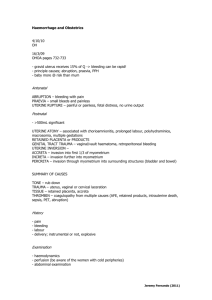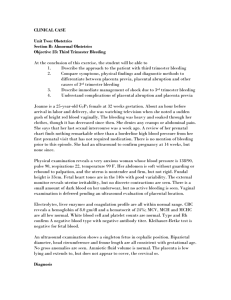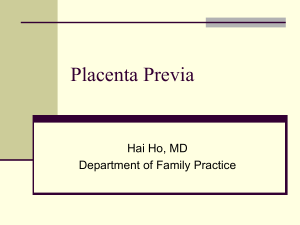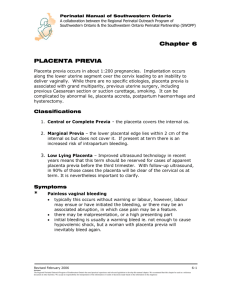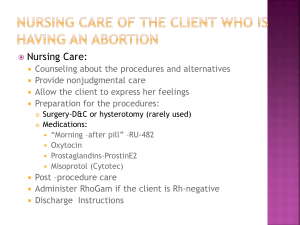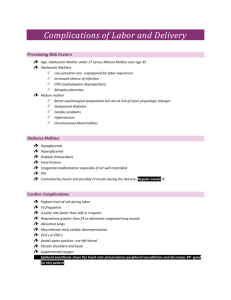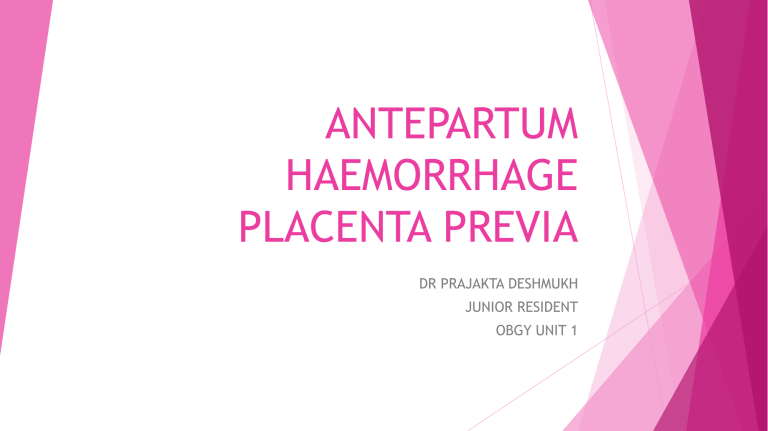
ANTEPARTUM HAEMORRHAGE PLACENTA PREVIA DR PRAJAKTA DESHMUKH JUNIOR RESIDENT OBGY UNIT 1 ANTEPARTUM HAEMORRHAGE Refers to vaginal bleeding after 20 weeks that is unrelated to labor and delivery. Any bleeding from the genital tract during pregnancy,after the period of viability until the delivery of the fetus . Incidence:4-5% Placenta previa = 20% Abruption= 30% Vasa previa Uterine rupture Pathology of cervix-erosion,polyp,tumor, Trichomonas vaginitis Varocosities,vulval/vaginal SYSTEMIC DISORDERS:- Von Willebrand’s disease and other bleeding diathesis,leukemia Excessive show Trauma-Fb, genital lacerations PLACENTA PREVIA Placental tissue that extends over internal os Incidence : 4 per 1000 births Risk factors: 1.Previous history of placenta previa (4-8%) 2.Previous caesarean section (47-60%) risk of pp increased as no. of caesarean section increases 3.Multifaetal pregnancy(40%) 4.Increasing parity 5.Increasing maternal age 6.Smoking/cocaine use Previous uterine surgery 7.Prior uterine artery embolization 8.Male fetus PATHOGENESIS Exactly unknown. Result of some local aberration in uteruine blood supply.the differentiation bet areas of chorionic frondosum and chorionic laevae does not occur.the blastocyst which usually implants in the thicker more receptive endometrium of the upper uterine segment gets implanted in the endometrium of the isthmusor over a previouslower uterine segment uterine scar.invasion by the trophoblast secures the embryo and whenthe uterus grows from to form lower segment later in pregnancy,the placenta is retained in lower segment. HYPOTHESIS- 1.Areas of suboptimally vascularized decidua in upper uterine cavity promotes implantation or growth of trophoblast towards lower uterine cavity 2.Large surface area of placenta increase probability of extension into lower uterine segment Cause of bleeding: Uterine contraction or gradual changes in cervix apply shearing forced to inelastic plastic attachments site result in partial detachment Vaginal examination/coitus can disrupts the site of attachment. Bleeding is maternal-from intervillous space PRESENTATION Placenta previa is finding on routine usg examination done 16-20 weeks 90% of these at 20 weeks will resolve before delivery WHY? 1.Lower uterine segment lengthens from 5mm to 50mm at term 2.Progressive unidirectional growth of trophoblastic tissue towards fundus(migration=TROPHOTROPISM) PREDICTING PLACENTA PREVIA PRESENCE AT DELIVERY 1.Extension over OS by >25mm 2.Posterior placenta previa 3.Lack of Resolution by 32 weeks 4.Degree of extension over os:<14mm- Low probability of Placenta previa at term >=14mm and < 25mm– Possibility=20% >=25mm over the os= 40 too 100% SYMPTOMS Mc symptom- Painless vaginal bledding in 90% of persistent cases Remaining 10-20%- uterine contraction and pain along with bleeding 1/3rd of women initial bleeding before 30 weeks these are at greater risk 1.Blood transfusion 2.Preterm labor 3.Perinatal mortality 1/3rd of women: bleeding between 30-36 weeks 1/3rd of women;1st bleeding >36weeks Diagnosis USG= placenta extending over internal os(mention the distance for which it extends over internal os) LOW LYING- placenta which is within 20mm from the internal os but not over the internal os TYPE1- (OLDER CLASSIFICATION=LOW LYING) TYPE 2,3,4, OLDER CLASSIFICAION= PLACENTA PREVIA Placenta >10mm away but within 20mm fromos at 32 weeks ------migrate to normal location,<10mm= persist 1st USG=TAS On TAS distance int os and pl<20mm—TVS(IOC FOR ABNORMALLY LOCATED PLACENTA) REASONS FOR FALSE REPORT 1.Overdistended bladder- compress the anterior segment against lower segment(false + pp) 2.Lower utherine segment is contractingbetween int os and placental edge. 3.Fetal head is low in pelvis – placenta previa can be missed 4.Posterior placenta is more difficult to visualise TVS= More sensitive for placental location and is safe. The probe 20-30mm away from cervix ADD DOPPLER? WHY? 1Placenta can be associated with abnormal attachment PAS(Placenta accreta spectum) 2To exclude vasa previa((specially if umbilical cord in lower uterne segment MRI Done if you are suspecting placenta accreta spectrum(percreta) PAS-should be high when pp+prev lscs 1st CS- RISK OF PAS=3% 2ND CS = 11% 3RD CS=40% 4TH CS=61% OTHER ASSOCIATED FINDINGS ON USG 1.Malpresentation 2.IUGR 3.Increased risk of congenital anomalies PP-Increased maternal morbidity and mortality APH(52%) and PPH(22%) Increase risk of blood transfusions Increase risk of hysterectomies And neonatal outcome: Preterm birth,Neonatal death MANAGEMENT 1. Asymptomatic Placenta Previa: GOAL: 1.Monitor placental location 2.See if placenta accrete present or not 3.Determine optimal time for Caesarian section 4.Decrease risk of bleeding 1.Monitor placenta location: Placental edge is <20mm from internal os FOLLOWUP USG at 32 weeks At 32 weeks if pl.edge is now >20mm from internal osReport as normal But if <2cm from internal os then repeat usg at 36weeks If At 36 weekspl. previaschedule caesarean section(until 37+6 weeks) AT 36 weeks pl does not cover int os but <2 cm from int os(LOW LYING) DISCUSS risks/benefits of trial of labour. 2.Placenta accreta spectrum 3.Decrease risk of bleeing: -Avoid sexual activity -Avoid moderate to strainous activity -Avoid heavy weight lifting -Avoid standing for prolonged period(>4HRS) -seek immediate help if – uterine contractions or bleeding occurs ASYMPTOMATIC PLACENTA PREVIA -These women can be managed as outpatient until vaginal bleeding or Admission for schedule C.S GIVE STEROIDS 48 HRS BEFORE C.S IF IT IS SCHEDULED AT <37WEEKS TIME OF DELIVERY:((ACOG)36WEEKS TO 37=6 WEEK IN WOMEN WITH UNCOMPLICATED PLACENTA PREVIA PICKED UP ON 2ND TRIMESTER SCAN ACUTE CARE OF BLEEDING PLACENTA PREVIA GOAL 1.Achieve or maintain nmaternal haemodynamic stability 2.Determine if emergency CS is needed. Maternal fetal assessment: -Maternal BP/HR/RR>O2 SATURATION/URINE OUTPUT BLOOD LOSS CAN BE QUANTIFIED -Fetus Continuous FHR monitoring Stabilization: IV access(2 large bore)+Crystalloids(RL/NS) +CBC,BG RH,COAGULATION PROFILE,ARRANGE FOR BLOOD OR BLOOD PRODUCTS. -UO=30ML/HR Initially , if fibrinogen>250mg/dl platelet=>1 lakh Then transfuse 2-4 units of crossed matched packed RBCs GoalHb>10gm% If patient fails to stabilize with theseintial measures then TRANSFUSE PRBC:FFP;PLATELET=(1:1:1) GOAL to stop bleedingRemove the cause TOP=CS INDICATIONSFOR CS: 1.Persistent vaginal bleeding with haemodynamic instability cannot be corrected 2.Active labour 3.Cat 3 FHR- 1. sinusoidal pattern 2.Absent b-b variability 3. any of the following– persistent bradycardia, persistent late decelerations or persistent variable decelerations 4.SIGNIFICANT bleeding >34 weeks EXPECTANT MANAGEMENT For stable patients or <34 weeks and quickly stabilized and not continuously bleeding Normal FHR JOHNSON’S AND MACAFFEE REGIMEN: 1.Monitor maternal fetal status 2.If the patient is <34 weekssterois for lung maturation 3.Correction of anaemia(injectable) 4.If Rh negative- Anti D(300 mcg anti D)- do not administer Anti D she bleeds within 3 weeks 5.Role of tocolyticsif <34weeks and ut is irritalble or mild contractionsGive tocolytic for steroid cover. NOT USED INDOMETHACIN, GIVE NIFEDIPINE NO ROLE OF CERVICAL ENCIRCLAGE Termination- AT 36-37+6 by CSa)Avoid disruting the placenta when entering the ut. b)If placenta is anterolateral can give vertical incision on the opposite side c)If placenta wraps around the cervix then make incision above placental margin IF PATIENT DEVELOPS PPH 1.Uterotonics Oxytocin+TRANEXA 1gm+MISOPROSTOL IF DOESN’T RESPOND THEN PGF2a/Methergin If still bleedingTOURNIQUET-temporary measure while surgical interventions are being considered (Bladder catheter-tied around ut as low as possible) 2.Focal areas of bleeding: Haemostatic square suture ,fibrin glue patches if available,ferric subsulfate(monsel’s patch) Placental site injection of vasopressin(4U in 20 ml saline) 3.Ligation of uterine artery and uteroovarian artery 4.uterine compression sutures(B lynch)or intrauterine balloon tamponade 4.Refractory patients Consider hysterectomy LOW LYING PLACENTA IF DISCTANCE FROM INT OS<=10MMCS IF DISTANCE IS 10-20MM FROM THE INT OS VD CAN BE PLANNED PAS-PLACENTA ACCRETA SPECTRUM ADHERENT PLACENTA-TROPHOBLASTIC INVASION INTO MYOMETRIUM PATHOGENESIS: PLACENTAL IMPLANTATION AT AN AREA OF DEFECTIVE DECIDUALIZATION CAUSED BY PREEXISTING DAMAGE TO ENDO-MYOMETRIAL INTERFACE(SCAR TISSUE) MOST IMP RIS FACTOR-PP+PREV CS ACCRETA-PLACENTAL VILLI ARE ATTACHED TO MYOMETRIUM IN PLACE OF DECIDUA INCRETA-PLACENTAL VILLI PENETRATE INTO THE MYOMETRIUM PERCRETA-PENETRATE THROUGH AND THROUGH THE MYOMETRIUM AND COME OUT THROUGH THE SEROSAL SURFACE PREVELENCE: ACCRETA-63% INCRETA-15% PERCRETA-15% 80% OF PAS OCCURS WITH H/O PRIOR cs? CURETTAGE/MYOMECTOMY REMAINING CASES: BICORNUATE UT,ADENOMYOSIS,FIBROID RF-PP+CS PP ITSELF CAN BE ASSOCIATED WITH PAS 2.UTERINE SX- MYOMECTOMY/ADHESIOLYSIS/D & C 3.Multiparity 4.smoking 5.ho manual removal of placenta Multifetal gestation Clinical presentation Suspected on USG IF Remains undiagnosed then profuse life threatening that occurs at the time of manual placental separation(no plane of separation) Possible lab findings: Increase mat serum AFP Consequences: 1.Massive pph refractory to routine DIC Ards Renal failure’complications from BT UTERINE rupture Peripartum hysterectomy death Diagnosis on atenatal usg –imp Usg-18-24 weeks Findings 1.placental lacunae(intraplacental sonolucent spaces) Heterogenous appearnces(MOTH EATEN PL) 2.Retroplacental thinning of myometrium 3.Disruption of interface between bladder wall and ut serosa(bladder line) 4.Loss of clear space behind the pl 5.Abnormal vessels-going from placeta to myo to bladder ADD DOPPLER: TURBULENT FLOW,BRIDGING VESSELS,HYPERVASCULARITY WITHSEROSA BLADDER INTERFACE,DIFFUSE OR FOCAL INTRAPARENCHYMAL BLOOD FLOW MRI-Gold standard K/C/O PAS- STABLE NO BLEEDING NO PTLCS HYSTERECTOMY 34-35=6 DELIVERY BEYOND 35 WEEKS NOT ADVISED CS HYSTERECTOMY Midline vertical or Cherney incision(skin) Pfannensteil incision in low risk patient Pelvis inspected for signs for percreta and any collateral blood supply Intraop-usg is useful to map the placental edge to determine position of ut incision Midline vertical hysterotomy incision 2 finger about breadth above the pl. incision After delivery of infant cord is cut and ut is incision is rapidly closed Proceed to hysterectomy During cs hyst measure to be taken 2 large iv access Thromboembolic prophylaxis pneumatic compression Ensure availability of blood products Drugs to control haemorrhage Women with percreta may need preop ureteral stents and 3 wax foleys catheter GA MOST COMMONLY USED LITHOTOMY POSITION/SUPINE LEGS FLAT ON TABLE Endovscular intervention- prophylactic ballon catheter in both int iliac or uae or combination of these is used Conservative management-role? For patients who very much wants to preserve fertility Risks When hyst has major risk of haemorrhage or injury to other organs When patient has focal accfreta-(placental resection) Types= 1.ut conservation with pl left insitu-done rarely Severe bleeding,sesis,2 hysterectomy,death.fistua formation,recurrent pl accrete Doing delayed hysteroscopicresection of pl remanants Delayed internal hysterectomy 2.ut conservation with pl resection-focal or fundalor posterior pl accreta
